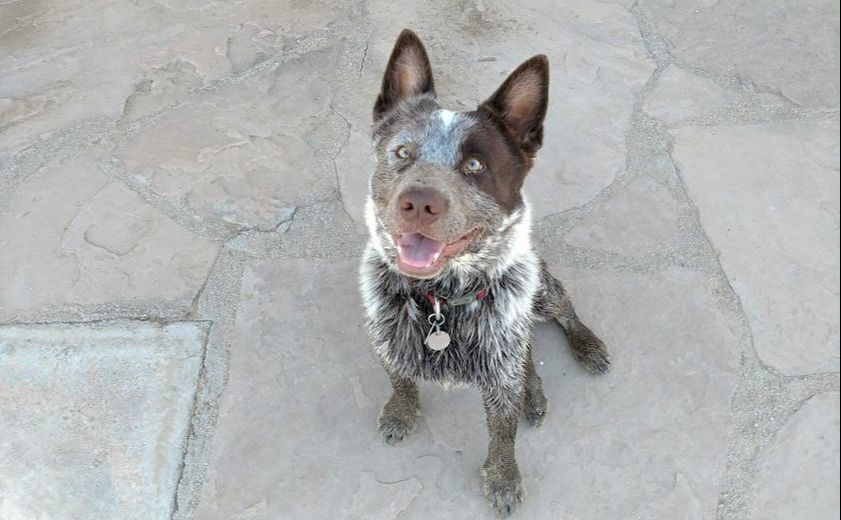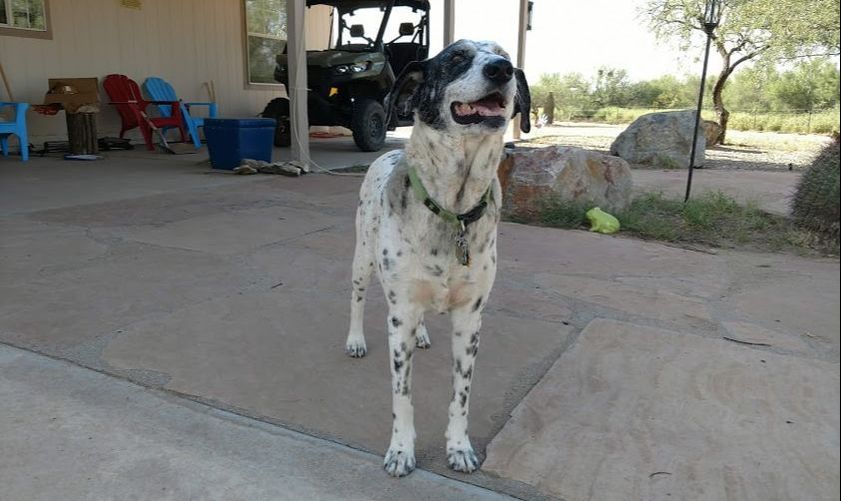|
This post may contain affiliate or sponsored links. Please read our Privacy Policy and Disclaimer.
All the dogs that have come into my life have been rescues. While I support responsible breeders, my heart is in rescuing. Since all the dogs I have adopted have been adults, they have a variety of issues that require training to fix. I am a huge believer in using positive reinforcement training. On rare occasion I use treats, but the vast majority of the time I reward my dogs with touch and verbal praise. However, some situations are so dangerous that my dogs need to know immediately that a behavior is not allowed. In these situations, I do train with a shock collar – set at the lowest effective level – for my dog’s safety. These are the four circumstances where I train my dogs with shock collars.
Chasing Horses
On our Montana ranch, any dog that chases livestock gets shot. Period. There’s no grace period, no forgiveness. The livestock are money, and worth more to my in-laws than a dog’s life. Until I adopted Lefty, I never owned a dog inclined to chase livestock, even though I have owned other herding dogs. (Read How To Live With High-Energy Farm Dogs Without Losing Your Mind to see how I keep my dogs entertained). Lefty came from the county shelter with only a little bit of information about his background since he was seized as part of a drug bust. Since I live in a fairly large city, I took a gamble that he had been a city dog and never had the opportunity to herd livestock. I was wrong. As soon as I got him home, it was clear that he had been allowed to chase horses before, and it was great fun for him.
Chasing horses is dangerous behavior for the dog and the horses. My horses generally won’t run from him, but they do kick at him and try to stomp him. I don’t want vet bills for horse or dog, so this behavior had to stop.
I initially tried to solve this problem with positive reinforcement training, and even hired one of the most respected dog trainers in the area to help me. Although Lefty learned the commands, his desire to chase horses still remained. It was time for the shock collar. I am a huge fan of PetSafe products, so I use the PetSafe Elite Remote Trainer (buy it here) for my dogs. We are still working on curbing Lefty’s instinct to chase horses, but in a short time the shock collar has been far more effective than positive reinforcement training. Yes, once he has the basic idea that he can’t chase horses we will use positive reinforcement to cement the idea in his mind, but for the immediate need to keep my dog and horses safe, the shock collar is the most effective tool.
Rattlesnakes
Living in the desert means that we frequently encounter rattlesnakes – even in town – so my vet encouraged me to take all my dogs to rattlesnake avoidance training. Although rattlesnake vaccine exists, my vet does not administer it, citing lack of proof that it works. Instead, one hour of rattlesnake training and annual retesting can save my dogs’ lives. The most effective training courses allow your dog to encounter muzzled snakes in realistic situations. The trainer teaches your dog to detect snakes by sight, scent, and sound, and to avoid them in all situations. Going near a rattlesnake is not okay – period. Every rattlesnake avoidance trainer I have met uses shock collars for training, and they are an effective tool for teaching a lifesaving skill in a short amount of time. This summer, Lefty found a rattlesnake less than a foot away from my three-year-old daughter and he did exactly what he was trained to do – mark it, alert, and leave it. This saved my daughter from a snakebite. No, he doesn’t need the shock collar anymore to make him avoid snakes. He just needed it for a short time to learn they are dangerous and must be left alone. Colorado River Toads When I moved to Arizona, I was completely unprepared for the Colorado River Toad invasion that happens every summer during monsoon season. The Colorado River Toad is the largest toad in North America and is extremely toxic to dogs. The toads have glands behind their eyes that secrete white poison to protect them from predators. If a dog picks up a toad in its mouth, it comes into instant contact with the poison and this can be life-threatening without immediate intervention. If your dog comes into contact with a toad, immediately flush your dog’s mouth out with water, and then contact a veterinarian. Signs of toad toxicity include disorientation, profuse drooling, seizures, difficulty breathing, and fever. Immediate veterinarian intervention is absolutely essential to prevent death. During monsoon season, my property looks like we are in the midst of a Biblical plague. Toads are EVERYWHERE from dusk to dawn. I had to take my dogs to toad avoidance training to protect their lives. Just like rattlesnake avoidance training, toad avoidance training involves encountering toads in realistic situations and correcting their desire to pick up the toad with the shock collar. After a one-hour training session, my dogs know how to mark toads and leave them without picking them up. This has saved their lives.
Wireless Fence
Living in the country means that predators traipse across my property on a regular basis. In the last six months I’ve encountered coyotes, two bobcats, and a mountain lion. I do have a small fenced yard for the dogs, but I have a lovely patio area that is too large to fence. The dogs like to spend time with us out there, so I invested in a PetSafe Stay + Play Wireless Fence (buy it here) to keep them close to the house. The wireless fence uses shock collars that beep and then let out a static shock when the dog reaches the fence’s boundary. If the dog crosses the boundary, the collar continues to shock for another 15 seconds. This wireless fence has been one of my best investments in my dogs. It keeps them safely near my house and out of the horse pens, but gives them the freedom to explore and play within a safe zone. I almost didn’t buy this wireless fence based on some negative reviews, but after talking to a friend who uses it successfully with her hunting dogs, I decided to try it. Here are some key things I’ve learned about it:
I love the PetSafe Stay + Play Wireless Fence. Once your dog understands how it works you can set the collar just to beep instead of shock, but I leave mine on shock because the area outside the boundary can be so dangerous for my dogs. The Stay + Play Wireless Fence only includes one collar, but you can buy extra ones here. The fence supports an unlimited number of collars.
For Safety
I believe in positive reinforcement training. Dogs can learn amazing things with positive reinforcement. However, some situations are so dangerous that dogs must know immediately that a certain behavior is not acceptable. I use the shock collar very sparingly and at the lowest effective setting, but it has been a valuable tool for keeping my dogs safe. Do you use a shock collar for training your dog, or do you use positive reinforcement? Let me know in the comments below!
4 Comments
Callie
11/26/2018 02:13:32 pm
Have you ever seen one that is avle to go in water and usrd again after its dried....I ride my mustang all over Oregon amd my dog goes with me...he is a well behaved well mannered dog without a mean bone in his body....but when I am in unknown territory I like to have him in a shock collar so IF needed I can get his attention right away...but...he lukes to swim as well...he takrs cate of himself on the trail...only bad thing is is old one no longer worked adter it went swimming a few times....just lookinh for suggestions and opinions
Reply
Alissa Berry
11/26/2018 03:50:31 pm
The PetSafe Elite Remote Trainer I recommend above is waterproof =) Just be sure that you put the attached rubber plug securely in the charging port. My dog swims in my koi pond and the horse trough with it daily (actually multiple times per day) and it still works perfectly. I' purchased it in May, and he really enjoyed swimming during our hot Arizona summer!
Reply
Peter Maxwell
5/21/2022 11:42:14 pm
Point taken on this. This is really what happens with dogs around livestock in ranches. I bought my shock collars and horse collars at the same store, https://ropingsupply.com/collections/breast-collars-and-tugs so it was really convenient for me.
Reply
5/22/2024 10:15:08 pm
Your blog about training farm dogs using shock collars is quite interesting and useful. It gives a balanced perspective and clear information, allowing dog owners to make more educated decisions. Thank you for sharing your insight!
Reply
Leave a Reply. |
AuthorWelcome! I've been a freelance writer since 2002 and have numerous horse-related articles published in print and online publications. I have a Bachelor of Science degree from Rocky Mountain College with a major in Equestrian Studies and a minor in Business Management. My current business ventures include High Plains Arena and real estate investing. Archives
March 2019
Categories
All
|
Proudly powered by Weebly





 RSS Feed
RSS Feed